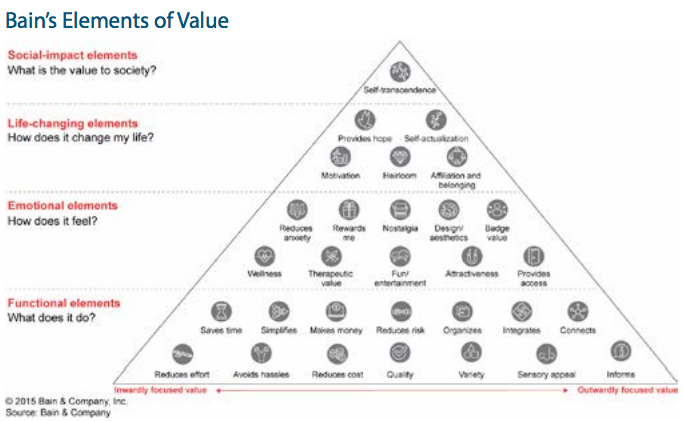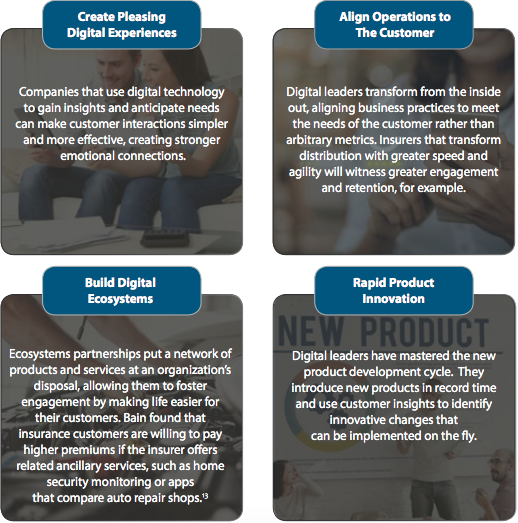Role of Unstructured Data in AI
Unstructured data will not only improve accuracy but achieve fundamentally new ways of thinking, communicating and using information.

Unstructured data will not only improve accuracy but achieve fundamentally new ways of thinking, communicating and using information.

Get Involved
Our authors are what set Insurance Thought Leadership apart.
|
Partner with us
We’d love to talk to you about how we can improve your marketing ROI.
|
To get on a path toward digital prominence, insurers need a strategy that ties legacy systems into future-proof distribution.

 To excel in these categories, however, insurers need to establish relationships with customers. According to Bain, staying in frequent contact, digitizing purchasing and servicing and offering ancillary services are the primary components of an insurer’s relationship-building strategy.
However, legacy technology and product silos impede insurers’ ability to swiftly react to customer inquiries and issues. Accessing the necessary information is often limited or time-consuming, and, when it comes to offering additional products or services, insurers are unable to extract the necessary insights quickly enough to make real-time product recommendations a reality.
Beyond technology considerations, 62% of organizations have failed to lay a solid foundation for transformation by establishing a plan and effectively communicating it to relevant stakeholders.
Planning and communication become necessary in light of the impact digitization has on the organization, particularly where resource management is concerned.
As insurers engage in digital transformations, processes within the organization change, affecting job functions and the people who perform them. McKinsey says that up to 25% of current business processes could be automated, resulting in the consolidation or elimination of up to 25% of full-time positions.
See also: Culture Side of Digital Transformation
Technology and automation also open doors to new roles and occupations. McKinsey points out that 25 years ago jobs in areas such as IT development, hardware manufacturing and app creation did not exist. Just as new employment opportunities arose out of the technology revolution, automation will generate demands for new skills, creating job roles in insurance that we can’t imagine today.
Part of a successful transition is understanding what processes will change and how those changes will affect existing roles across the organization. Envisioning new roles at the beginning allows insurers to identify existing talent that can be upskilled or reskilled to fill new vacancies.
Making for Successful Digital Transformations
At the heart of successful digital transformations is a focus on the customer. Digital leaders understand this, with 92% reporting that customer experience is central to their strategy.
Digital leaders, such as Amazon, become industry giants because they can tie revenue outcomes to specific measures of customer satisfaction and tweak or completely revolutionize their business approach accordingly.
According to Forrester, digital leaders succeed by adhering to four basic principles:
To excel in these categories, however, insurers need to establish relationships with customers. According to Bain, staying in frequent contact, digitizing purchasing and servicing and offering ancillary services are the primary components of an insurer’s relationship-building strategy.
However, legacy technology and product silos impede insurers’ ability to swiftly react to customer inquiries and issues. Accessing the necessary information is often limited or time-consuming, and, when it comes to offering additional products or services, insurers are unable to extract the necessary insights quickly enough to make real-time product recommendations a reality.
Beyond technology considerations, 62% of organizations have failed to lay a solid foundation for transformation by establishing a plan and effectively communicating it to relevant stakeholders.
Planning and communication become necessary in light of the impact digitization has on the organization, particularly where resource management is concerned.
As insurers engage in digital transformations, processes within the organization change, affecting job functions and the people who perform them. McKinsey says that up to 25% of current business processes could be automated, resulting in the consolidation or elimination of up to 25% of full-time positions.
See also: Culture Side of Digital Transformation
Technology and automation also open doors to new roles and occupations. McKinsey points out that 25 years ago jobs in areas such as IT development, hardware manufacturing and app creation did not exist. Just as new employment opportunities arose out of the technology revolution, automation will generate demands for new skills, creating job roles in insurance that we can’t imagine today.
Part of a successful transition is understanding what processes will change and how those changes will affect existing roles across the organization. Envisioning new roles at the beginning allows insurers to identify existing talent that can be upskilled or reskilled to fill new vacancies.
Making for Successful Digital Transformations
At the heart of successful digital transformations is a focus on the customer. Digital leaders understand this, with 92% reporting that customer experience is central to their strategy.
Digital leaders, such as Amazon, become industry giants because they can tie revenue outcomes to specific measures of customer satisfaction and tweak or completely revolutionize their business approach accordingly.
According to Forrester, digital leaders succeed by adhering to four basic principles:
 A customer focus during digital transformations ensures that outcomes meet the intended objectives. Insurers can plan from the outset to build the necessary speed and efficiency into digital channels while ensuring cross-functional capabilities.
A recent consumer study conducted by Facebook and comScore revealed that the typical insurance-buying journey is short. Thirty percent of consumers made a decision within a day, while the same number took less than a week to select their insurer.
That gives insurers a short window of opportunity to engage with consumers and secure their business.
According to J.D. Power, a preference for digital interactions is on the rise. In their surveys, over 60% of consumers use online channels when researching insurers, but only 42% use these channels to purchase.
Pitted against consumer expectations shaped by the Amazon experience, too many insurers fail in speed, efficiency and convenience, J.D. Power says, forcing consumers to seek out more digitally proficient insurers or to switch to other channels when purchasing coverage.
Filling the Gap with Digital Transformations
When it comes to improving the customer experience, insurers are filling the gap between expectations and reality by ramping up their digital capabilities. In a recent survey of industry executives conducted by SAP, 85% were prioritizing the development of digital and mobile channels.
Findings like these indicate that insurers understand the need for digital engagement. However, there is no indication that insurers have conquered the impediments to creating an efficient omni-channel environment. To do so, they need to unite back-end systems to obtain a complete view of the customer, including every policy on record, as well as consumer data and related insights.
With legacy technology and siloed systems at the top of executive concerns, it’s no wonder that business leaders are partnering when it comes to gaining digital capabilities. Respondents to the IDG study expect more than 1/3 of their transformation initiatives to be handled by a third party. This approach is particularly applicable to the insurance industry where overhauling systems is risky and problematic.
“In a time of disruption, the smartest insurers recognize they can’t do everything on their own. They’re teaming up with insurtechs and other companies to modernize their operations, from distribution to claims processing,” said Dr. Henrik Naujoks, head of Bain & Co.’s financial services practice in Europe, the Middle East and Africa.
Integrating third-party solutions with existing technology puts insurers on the digital fast track without the worry of disrupting data held in traditional systems. According to Rick Huckstep, chairman, Digital Insurer, the insurer’s existing system becomes the system of record, while digital distribution platforms supply the digital front end.
In the process, back-end systems are connected through a single point of access, providing clear visibility across policies to all channels. This capability is necessary to ensure an efficient omni-channel experience for the customer.
By connecting all policy silos, agents and customers are able to quote, issue and bind multiple policies from a single application. Through automation, the process is completed in minutes, ensuring that insurers capture customer purchasing intentions at the moment they are ready to buy.
See also: Future of Digital Transformation
Digital distribution platforms also simplify the approach to ecosystem environments, providing insurers with a ready platform for connecting with ancillary service providers or other insurers.
Bain’s in-depth consumer research reveals that digital leaders are excelling with three main capabilities. These core components of a leading digital strategy are all easily addressed with the application of a digital distribution platform:
Core Business
High-quality products are delivered at competitive prices. Customer experiences are simple and digital.
How a Digital Distribution Platform Helps: Automating much of the quote-to-issue lifecycle reduces insurer costs and provides an ecosystem environment where insurers can connect with other insurance companies. By using products from other insurers to meet price points or when there is no appetite for the risk, insurers can always fulfill the needs of their customers.
Going Beyond Insurance
Insurers foster engagement and a sense of affiliation by offering ecosystem services from third-party providers.
How a Digital Distribution Platform Helps: Outside vendors can be connected to digital distribution platforms, allowing customers to move freely from the insurer’s website to third-party applications. Customers can simply and easily take advantage of ancillary services right from the insurer’s website.
Prioritize Innovation
Insurers understand the urgency behind digital initiatives and push for speedy digital transformations.
How a Digital Distribution Platform Helps: Digital distribution platforms provide insurers with a complete digital environment, from online storefront through back-end integration, in a matter of weeks.
Connecting with digital distribution platforms drastically improves the odds of transformation success. Aside from implementation simplicity, insurers gain the benefit of expertise.
Platform providers are well-versed in the impacts that transforming to digital distribution have across the organization and are equipped to lead insurers through the process. They advise on staff changes and have resources on hand to fill talent gaps, thereby increasing the odds of success.
A customer focus during digital transformations ensures that outcomes meet the intended objectives. Insurers can plan from the outset to build the necessary speed and efficiency into digital channels while ensuring cross-functional capabilities.
A recent consumer study conducted by Facebook and comScore revealed that the typical insurance-buying journey is short. Thirty percent of consumers made a decision within a day, while the same number took less than a week to select their insurer.
That gives insurers a short window of opportunity to engage with consumers and secure their business.
According to J.D. Power, a preference for digital interactions is on the rise. In their surveys, over 60% of consumers use online channels when researching insurers, but only 42% use these channels to purchase.
Pitted against consumer expectations shaped by the Amazon experience, too many insurers fail in speed, efficiency and convenience, J.D. Power says, forcing consumers to seek out more digitally proficient insurers or to switch to other channels when purchasing coverage.
Filling the Gap with Digital Transformations
When it comes to improving the customer experience, insurers are filling the gap between expectations and reality by ramping up their digital capabilities. In a recent survey of industry executives conducted by SAP, 85% were prioritizing the development of digital and mobile channels.
Findings like these indicate that insurers understand the need for digital engagement. However, there is no indication that insurers have conquered the impediments to creating an efficient omni-channel environment. To do so, they need to unite back-end systems to obtain a complete view of the customer, including every policy on record, as well as consumer data and related insights.
With legacy technology and siloed systems at the top of executive concerns, it’s no wonder that business leaders are partnering when it comes to gaining digital capabilities. Respondents to the IDG study expect more than 1/3 of their transformation initiatives to be handled by a third party. This approach is particularly applicable to the insurance industry where overhauling systems is risky and problematic.
“In a time of disruption, the smartest insurers recognize they can’t do everything on their own. They’re teaming up with insurtechs and other companies to modernize their operations, from distribution to claims processing,” said Dr. Henrik Naujoks, head of Bain & Co.’s financial services practice in Europe, the Middle East and Africa.
Integrating third-party solutions with existing technology puts insurers on the digital fast track without the worry of disrupting data held in traditional systems. According to Rick Huckstep, chairman, Digital Insurer, the insurer’s existing system becomes the system of record, while digital distribution platforms supply the digital front end.
In the process, back-end systems are connected through a single point of access, providing clear visibility across policies to all channels. This capability is necessary to ensure an efficient omni-channel experience for the customer.
By connecting all policy silos, agents and customers are able to quote, issue and bind multiple policies from a single application. Through automation, the process is completed in minutes, ensuring that insurers capture customer purchasing intentions at the moment they are ready to buy.
See also: Future of Digital Transformation
Digital distribution platforms also simplify the approach to ecosystem environments, providing insurers with a ready platform for connecting with ancillary service providers or other insurers.
Bain’s in-depth consumer research reveals that digital leaders are excelling with three main capabilities. These core components of a leading digital strategy are all easily addressed with the application of a digital distribution platform:
Core Business
High-quality products are delivered at competitive prices. Customer experiences are simple and digital.
How a Digital Distribution Platform Helps: Automating much of the quote-to-issue lifecycle reduces insurer costs and provides an ecosystem environment where insurers can connect with other insurance companies. By using products from other insurers to meet price points or when there is no appetite for the risk, insurers can always fulfill the needs of their customers.
Going Beyond Insurance
Insurers foster engagement and a sense of affiliation by offering ecosystem services from third-party providers.
How a Digital Distribution Platform Helps: Outside vendors can be connected to digital distribution platforms, allowing customers to move freely from the insurer’s website to third-party applications. Customers can simply and easily take advantage of ancillary services right from the insurer’s website.
Prioritize Innovation
Insurers understand the urgency behind digital initiatives and push for speedy digital transformations.
How a Digital Distribution Platform Helps: Digital distribution platforms provide insurers with a complete digital environment, from online storefront through back-end integration, in a matter of weeks.
Connecting with digital distribution platforms drastically improves the odds of transformation success. Aside from implementation simplicity, insurers gain the benefit of expertise.
Platform providers are well-versed in the impacts that transforming to digital distribution have across the organization and are equipped to lead insurers through the process. They advise on staff changes and have resources on hand to fill talent gaps, thereby increasing the odds of success.
Get Involved
Our authors are what set Insurance Thought Leadership apart.
|
Partner with us
We’d love to talk to you about how we can improve your marketing ROI.
|

Tom Hammond is the chief strategy officer at Confie. He was previously the president of U.S. operations at Bolt Solutions.
What might a future world look like where all transportation is via autonomous vehicles? Here are 10 possibilities.

Get Involved
Our authors are what set Insurance Thought Leadership apart.
|
Partner with us
We’d love to talk to you about how we can improve your marketing ROI.
|

Mark Breading is a partner at Strategy Meets Action, a Resource Pro company that helps insurers develop and validate their IT strategies and plans, better understand how their investments measure up in today's highly competitive environment and gain clarity on solution options and vendor selection.
Cyber liability and technology E&O insurers are not only giving hackers the upper hand but are endangering their own existence.

Get Involved
Our authors are what set Insurance Thought Leadership apart.
|
Partner with us
We’d love to talk to you about how we can improve your marketing ROI.
|

Jesse Lyon works in financial fields that involve retail banking, residential property valuation and professional insurance. He is deeply interested in the fields of cyber liability and technology E&O, and his research has led to four published papers on those topics in the U.S. and the U.K.
Recent research shows that auto insurance carriers are succeeding in striking a balance between empathy and automation in claims.

Get Involved
Our authors are what set Insurance Thought Leadership apart.
|
Partner with us
We’d love to talk to you about how we can improve your marketing ROI.
|

Bill Brower is senior vice president, industry relations and North America claims sales, at Solera.
Customers now demand choice in how and when they engage. That means insurers must provide a digital, yet humanized, claims experience.

Get Involved
Our authors are what set Insurance Thought Leadership apart.
|
Partner with us
We’d love to talk to you about how we can improve your marketing ROI.
|

Mariana Dumont is the head of U.S. operations at Insurance Nexus and is currently focused on helping carriers to transform claims processes to deliver a seamless claims experience.
Want to generate underwriting income without raising massive amounts of capital or waiting a year to get regulated? Consider an MGA.

Get Involved
Our authors are what set Insurance Thought Leadership apart.
|
Partner with us
We’d love to talk to you about how we can improve your marketing ROI.
|

Matthew Grant is the CEO of Instech, which publishes reports, newsletters, podcasts and articles and hosts weekly events to support leading providers of innovative technology in and around insurance.
A digital agent has interacted with 250,000 customers through conversational AI and answers 70% of all incoming customer interactions.

Get Involved
Our authors are what set Insurance Thought Leadership apart.
|
Partner with us
We’d love to talk to you about how we can improve your marketing ROI.
|

Henry Vaage Iversen is chief commercial officer and co-founder of Boost.ai. He helps drive global growth at Boost.ai, a privately held software company that specializes in conversational artificial intelligence.
Once considered the best way to do business, the spreadsheet is now being reevaluated on whether it is the right tool for the job.

Get Involved
Our authors are what set Insurance Thought Leadership apart.
|
Partner with us
We’d love to talk to you about how we can improve your marketing ROI.
|

Jim Leftwich has more than 30 years of leadership experience in risk management and insurance. In 2010, he founded CHSI Technologies, which offers SaaS enterprise management software for small insurance operations and government risk pools.
As the number of insurtech firms grew exponentially, so did the number of conferences on the subject. One stands out to the author.

Get Involved
Our authors are what set Insurance Thought Leadership apart.
|
Partner with us
We’d love to talk to you about how we can improve your marketing ROI.
|

Guy Fraker has 30 years within the insurance industry and been on the leading edge of building innovation systems for the past 10 years spanning primary carriers, reinsurers and related sectors.